
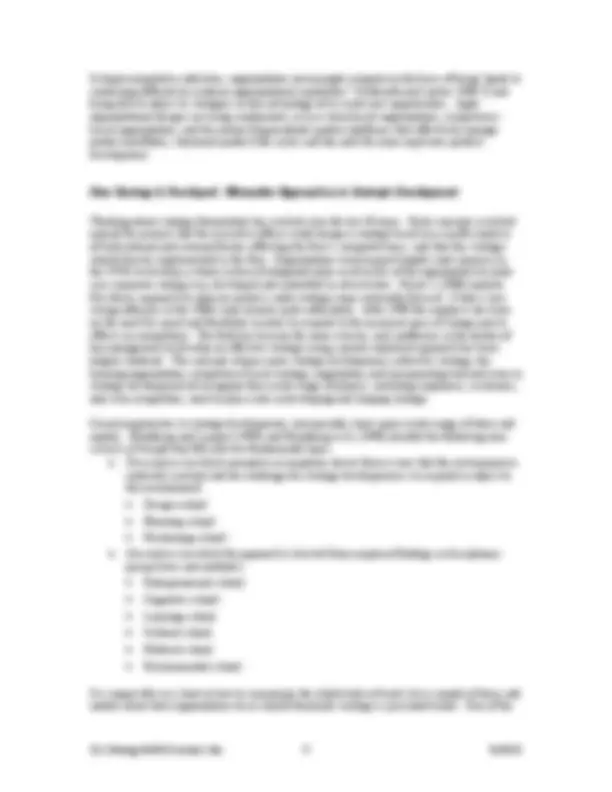
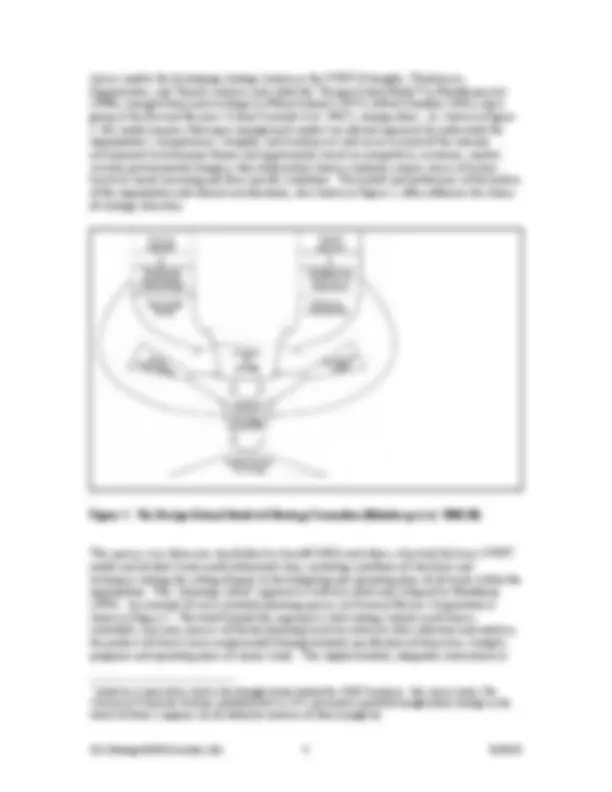
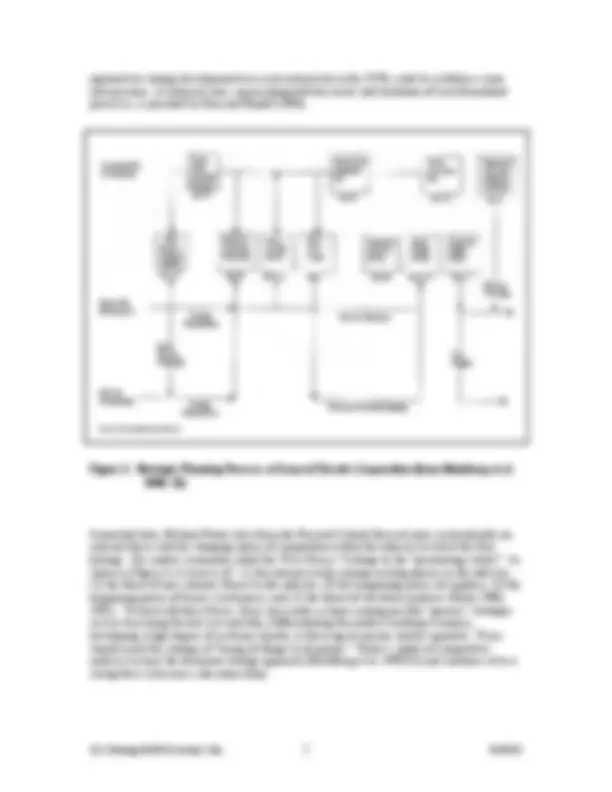
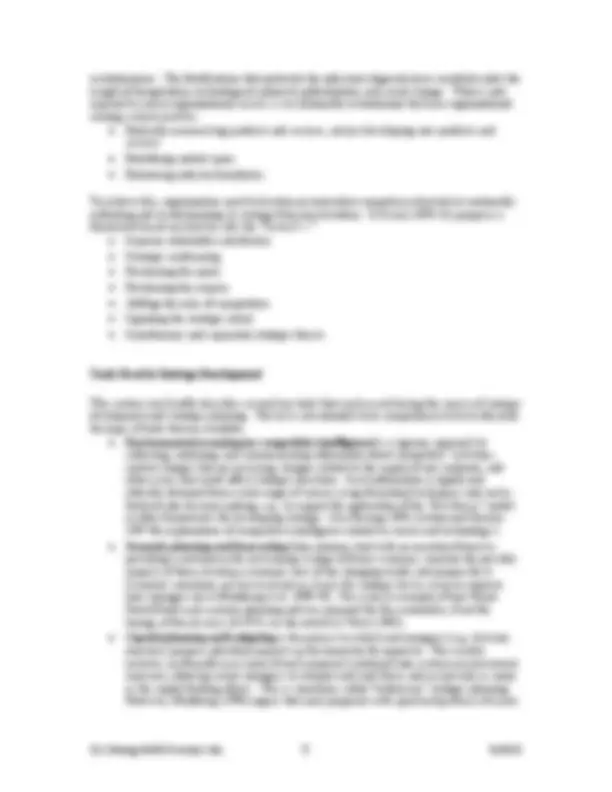
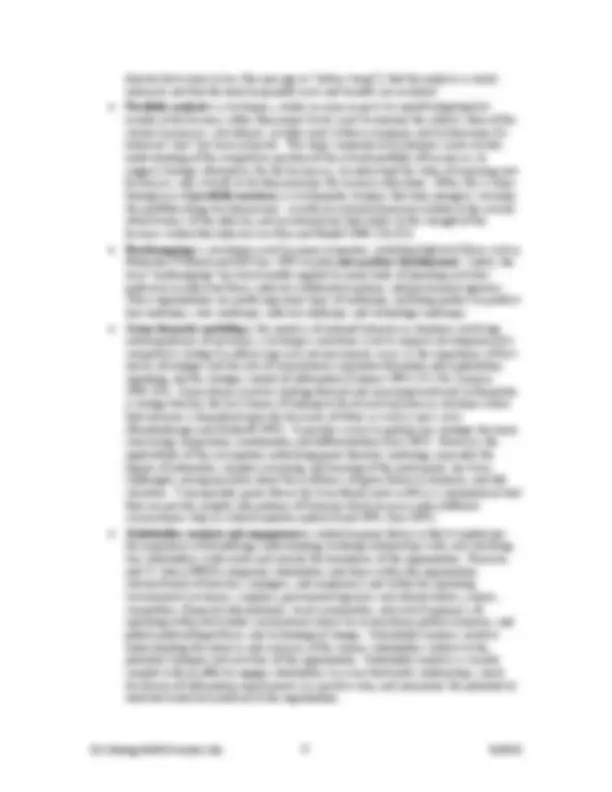
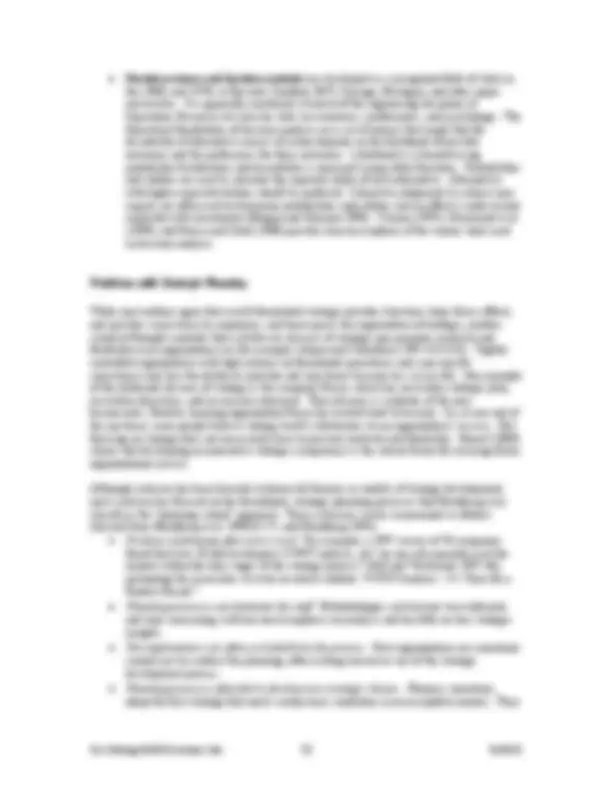
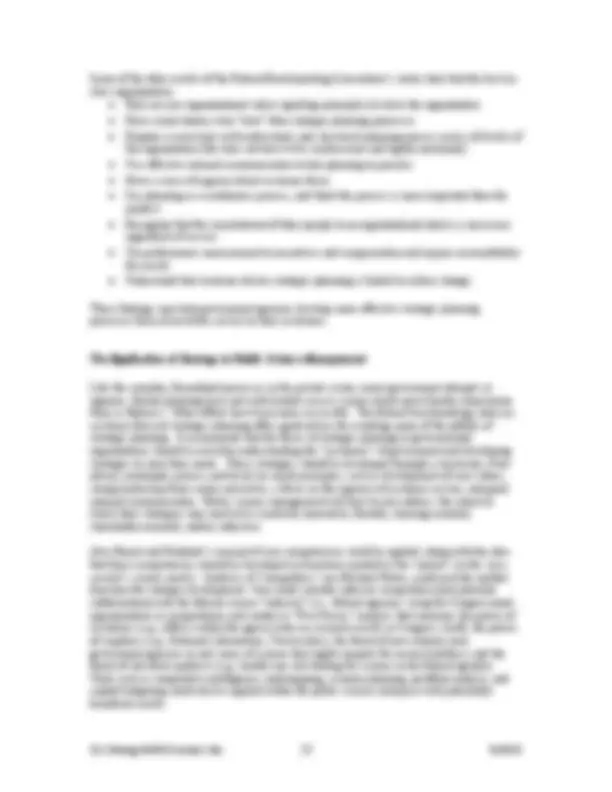
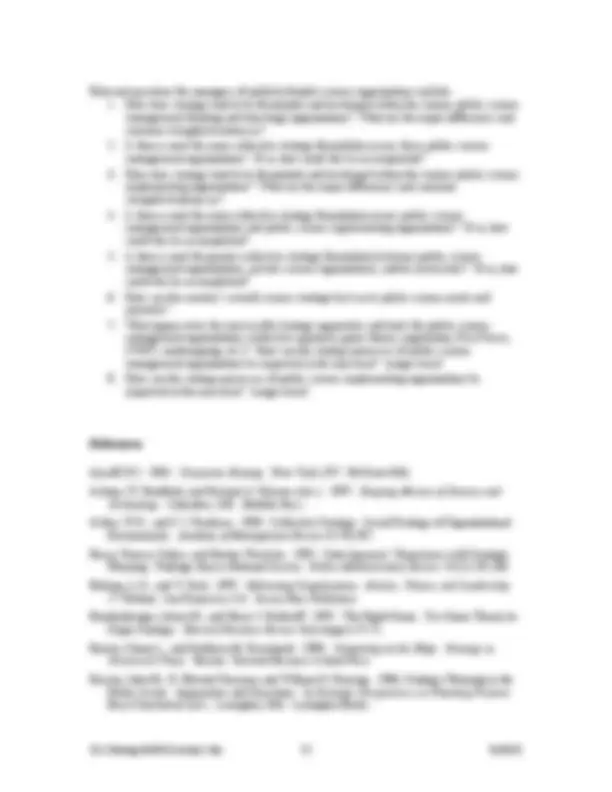
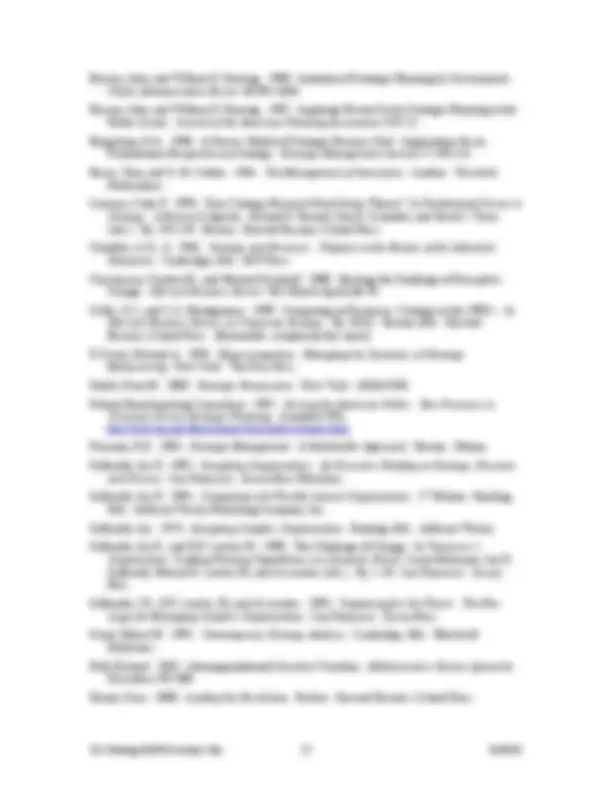


Study with the several resources on Docsity

Earn points by helping other students or get them with a premium plan


Prepare for your exams
Study with the several resources on Docsity

Earn points to download
Earn points by helping other students or get them with a premium plan
Community
Ask the community for help and clear up your study doubts
Discover the best universities in your country according to Docsity users
Free resources
Download our free guides on studying techniques, anxiety management strategies, and thesis advice from Docsity tutors
How Strategy Is Developed: Alternative Approaches to Strategic Development Management Benchmark Study-Book Summary Chapter 03-Literature-Elizabeth L. Malone Strategy, Marylynn Placet and Kristi M. Branch, Strategy and Organizational Design, Design School Model, Strategic Planning Process, Five Forces Shaping Strategy, Environmental scanning, portfolio matrices, Game theoretic modeling
Typology: Summaries
1 / 17

This page cannot be seen from the preview
Don't miss anything!










The word “strategy” has been in use since Sun Tzu wrote the Art of War in the fourth century B.C. (Sun Tzu 1971). Sun Tzu wrote, of course, about military strategy. The literature on corporate strategy, which emerged in the 1950s and 1960s (Chandler 1962; Ansoff 1965; Learned et al. 1965) is vast and continues to grow at an astonishing rate. S trategic management – the way in which a firm identifies its strategic direction and aligns its operational processes to its strategy – has become an academic discipline in its own right, like marketing and finance (Mintzberg et al. 1998:18; Rumelt et al. 1994:15). In essence, strategy has to do with understanding where an organization will go in the future and how it will get there. Most academicians and corporate managers believe strategy affects the overall welfare of the corporation, and strategy making is an important activity, though a few believe firms are better off without a strategy (see Inkpen and Choudhury 1995). Many who believe strategy is important, however, find fault with the ability of formalized strategic planning processes to deal adequately with the pace of change facing organizations in today’s environment.
The disruptive changes created by revolutionary technologies (including communication and information processing technologies), globalization, and new business methods can turn an organization’s current advantages into barriers for future success and have led to new thinking about the focus and goal of strategy (Christensen and Overdorf 2000; Miller and Morris 1999; D’Aveni 1994; Brown and Eisenhardt 1998; Tushman and Anderson 1997). D’Aveni (1994) and Dudik (2000) argue that under the dynamic conditions affecting many organizations today, which D’Aveni calls hypercompetition , strategy that seeks to sustain organizational advantage needs to be replaced with strategy that seeks to establish flexibility and the ability to disrupt the advantages of competitors. This perspective places an emphasis on competition and the ability of the organization to change the rules of the game or the game it chooses to play. Consequently, the pace of change has placed greater emphasis on developing strategies that can successfully take advantage of changing situations rather than on designing a single strategy for success.
Public science organizations find themselves in a challenging position. On the one hand, they are participating at the cutting edge of knowledge, where the goal is to achieve transforming breakthroughs in theory, materials, processes, and/or tools and to utilize breakthroughs achieved by other research organizations. They must be able to be agile in determining managing their current scientific direction and future science strategies. On the other hand, they tend to be embedded in large-scale institutions that are permeated by cumbersome, slow, and change- resistant procedures and political processes.
This review addresses definitions of strategy, approaches to strategy development, tools typically used in strategy development, problems with strategic planning, and the role of strategic planning in government. It concludes by discussing the implications of this literature for managing publicly funded science programs and science organizations.
(^1) Related chapters include: Science Policy; Change Management, Competencies; Organizational Culture;
Leadership; Organizational Communication; Innovation.
Many strategic management textbooks exist, each with its own definition of strategy. For instance, Mintzberg and Quinn (1996:3) define a strategy as
the pattern or plan that integrates an organization’s major goals, policies, and action sequences into a cohesive whole. A well-formulated strategy helps to marshal and allocate an organization’s resources into a unique and viable posture based on its relative internal competencies and shortcomings , anticipated changes in the environment and contingent moves by intelligent opponents (emphasis included in the original).
Thompson and Strickland (1993:6) define strategy as “the pattern of organizational moves and managerial approaches used to achieve organizational objectives and to pursue the organization’s mission.” Michael Porter (1996) states: “The essence of strategy is choosing to perform activities differently than rivals do.” D’Aveni (1994) takes the view that strategy is not only the creation of advantage but “also the creative destruction of the opponent’s advantage.” Brown and Eisenhardt (1998:4) define strategy as “the creation of a relentless flow of competitive advantages that, taken together form a semi-coherent strategic direction.”
In their recent book, Mintzberg et al. (1998:9) contend, “[S]trategy is one of those words that we inevitably define in one way yet often also use in another.” Most people think of strategy as a plan – a direction, a guide, or course of action into the future. But when asked to describe a strategy actually pursued, people tend to describe a pattern or a set of behaviors over time, e.g., a company that perpetually markets the most expensive products is said to pursue a “high-end strategy.” So strategy can be defined as a pattern of behavior. Mintzberg et al. include several other ways of defining strategy: Strategy is “position” – selling particular products in particular markets. Strategy is “perspective” – an organization’s fundamental way of doing things, e.g., the “McDonald’s way.” Strategy is “ploy” – a specific maneuver intended to outwit a competitor. The five P’s (plan, pattern, position, perspective, and ploy) serve as a key aspect of Mintzberg et al.’s framework for analyzing different schools of thought about strategy.
The concepts of organizational design and the resource theory of the firm have greatly influenced recent discussions of strategy. It is generally recognized that a good fit between strategy, organizational design, and external opportunity creates a competitive advantage for an organization (Galbraith et al. 1993; Galbraith 1994; Tushman et al. 1997:583).^2 An appropriate organizational design is generally viewed as enabling “an organization to execute better, learn faster, and change more easily” (Mohrman et al. 1995:7). An organization’s design comprises multiple, interrelated elements, frequently categorized as structure, people, processes, rewards, and tasks or work systems that together can create unique organizational capabilities that provide competitive advantage (Quinn et al. 1997; Galbraith 1994, 1995). Although the classic bureaucratic form may be the form of choice in a stable environment with low complexity, research has shown that rapid change and increased complexity require greater lateral mechanisms and a more organic form (Galbraith 1973, 1994; Burns and Stalker 1961; Hall 1962).
(^2) D’Aveni (1994:31) disputes this on the grounds that it implies permanence. He says that organizations
need to prepare for hypercompetition in an entirely different way, focusing on creating disruption, seizing the initiative, and creating a series of temporary advantages.
classic models for developing strategy, known as the SWOT (Strengths, Weaknesses, Opportunities, and Threats) analysis and called the “Design School Model” by Mintzberg et al. (1998), emerged from early writings by Philip Selznick (1957), Alfred Chandler (1962), and a group at the Harvard Business School (Learned et al. 1965^3 ), among others. As shown in Figure 1, this model requires that upper management conduct an internal appraisal (to understand the organization’s competencies, strengths, and weaknesses) and an assessment of the external environment (to determine threats and opportunities based on competitive, economic, market, societal, governmental changes), then deliberately choose a tailored, unique course of action based on sound reasoning and firm-specific conditions. The beliefs and preferences of the leaders of the organization and ethical considerations, also shown in Figure 1, often influence the choice of strategic direction.
This process was taken one step further by Ansoff (1965) and others, who took the basic SWOT model and divided it into neatly delineated steps, including a plethora of checklists and techniques linking the setting of goals to the budgeting and operating plans of all levels within the organization. This “planning school” approach is both described and critiqued by Mintzberg (1994). An example of such a detailed planning process (at General Electric Corporation) is shown in Figure 2. The belief behind this approach is that strategy should result from a controlled, conscious process of formal planning based on extensive data collection and analysis, the product of which can be implemented through detailed specification of objectives, budgets, programs and operating plans of various kinds. This highly detailed, integrated, data-intensive
(^3) Andrews is most often cited as the thought leader behind the SWOT analysis. His classic book, The
Concept of Corporate Strategy , published first in 1971, presented a powerful insight about strategy as the subset of what a company can do within the universe of what it might do.
approach to strategy development was used extensively in the 1970s, until its usefulness came into question. A balanced view, representing both the merits and limitation of such formalized processes, is provided by Hax and Majluf (1996).
Somewhat later, Michael Porter (also from the Harvard School) focused more systematically on external forces and the changing nature of competition within the industry to which the firm belongs. His model, commonly called the “Five Forces,” belongs to the “positioning school.” As shown in Figure 3, it consists of: (1) the internal rivalry among existing players in the industry, (2) the threat of new entrants (firms) to the industry; (3) the bargaining power of suppliers, (4) the bargaining power of buyers (customers), and (5) the threat of substitute products (Porter 1980, 1991). To deal with these forces, firms must make a choice among possible “generic” strategies such as becoming the low-cost provider, differentiating the product (making it unique), developing a high degree of customer loyalty, or focusing on narrow market segments. Firms should avoid the strategy of “being all things to all people.” Porter’s model of competitive analysis became the dominant strategy approach (Mintzberg et al. 1998:82) and continues to be a strong force in business education today.
Combining ideas from both Porter (with the industry analysis or external focus) and Hamel and Prahalad (with the capabilities and learning focus), Collis and Montgomery (1999) developed a resource-based view of the firm, which saw “capabilities and resources as the heart of a company’s competitive position,” subject to the interplay of three fundamental market forces: (1) demand (does it meet customers’ needs and is it competitively superior?), (2) scarcity (is it imitable or substitutable, and is it durable?), and (3) appropriability (who owns the profits?). This approach provides guidance on how to identify and assess the resources of the organization and their ability to enable the organization to compete successfully.
James Brian Quinn (1980) discusses logical incrementalism , which describes the phenomenon of developing a consistent pattern among decisions made in the series of “subsystems” present in an organization, e.g., the subsystems for diversification, external relations, and human resources. The top executive or top executive team is the architect of the strategy or vision (which develops over time), and this vision is implemented politically through building credibility, broadening support, systematic waiting, and managing coalitions.
Noda and Bower (1996) describe research, primarily by Burgelman (1996), that investigates how strategic initiatives “emerge” from managerial activities of front-line and middle managers (or from virtually anywhere people have the capacity to learn and the resources to support that capacity). Top managers merely exercise critical influences by setting up structural context (organizational and administrative mechanisms, such as measurement systems, reward systems, organizational structure) to reflect corporate objectives, thereby manipulating the way decisions and actions of lower-level staff members are made. This is sometimes called a “grassroots model” of strategy formation and is part of the “learning school” approach to strategy (Mintzberg et al. 1998:196).
The literature also discusses strategy formation as a process of negotiation, focusing on the role of power relations in strategy development. Mintzberg et al. (1998:236) assert: “Introduce any form of ambiguity – environmental uncertainty, competing goals, varied perceptions, scarcity of resources – and politics arises.” Along these lines, Bolman and Deal (1997:163) claim that: “Goals and decisions emerge from bargaining, negotiation, and jockeying for position among different stakeholders.” Regarding strategic maneuvering, Porter (1980:91) contends: “Many moves that would significantly improve a firm’s position do threaten competitors…. Thus a key to success … is predicting and influencing retaliation.” Cooperation is also a potential offshoot of power relations. Astley and Fombrun (1983) coined the term collective strategy to describe the joint nature of strategy formation among interdependent companies or networks (e.g., efforts within the banking industry to develop ATMs).
In a recent book, Markides (2000) stresses that the process of developing superior strategies is part planning and part trial and error. He argues that a company must develop its strategy by asking “Who should we target as customers, what should we offer them, and how should we go about it?” They should “…raise these questions, identify possible answers, evaluate the answers, and make a choice. The objective should be to come up with ideas that differentiate the firm from its competitors. Therefore, the more creative the ideas, the better.” He asks, “Do creative new strategies emerge from planning, or is something else involved?” He concludes, “Analysis and planning will not produce a full-fledged strategy ready for implementation, but they will help narrow the options. Experimentation should then follow on that limited set of options, out of which the final strategy will emerge” (Markides 2000:147-149).
Hamel (1996, 2000) contends that radical strategy innovation has now become paramount. He claims that the current environment is hostile to industry incumbents and hospitable to industry
revolutionaries. The fortifications that protected the industrial oligarchy have crumbled under the weight of deregulation, technological upheaval, globalization, and social change. What is now required to ensure organizational success is to continually revolutionize the basic organizational strategy, which involves: ♦ Radically reconceiving products and services, not just developing new products and services ♦ Redefining market space ♦ Redrawing industry boundaries.
To achieve this, organizations need to develop an innovation competency directed at continually rethinking and revolutionizing its strategy from top to bottom. D’Aveni (1994:31) proposes a framework based on what he calls the “Seven S’s:” ♦ Superior stakeholder s atisfaction ♦ Strategic s oothsaying ♦ Positioning for s peed ♦ Positioning for s urprise ♦ S hifting the rules of competition ♦ Signaling the s trategic intent ♦ Simultaneous and sequential s trategic thrusts.
This section very briefly describes several key tools that can be used during the course of strategy development and strategic planning. The list is not intended to be comprehensive but to illustrate the types of tools that are available. ♦ Environmental scanning (or competitive intelligence) is a rigorous approach to collecting, analyzing, and communicating information about competitors’ activities, market changes that are occurring, changes related to the supply of raw materials, and other issues that could affect strategic directions. Such information is legally and ethically obtained from a wide range of sources using formalized techniques and can be factored into decision making, e.g., to support the application of the “five-forces” model or other frameworks for developing strategy. (See Herring 1993; Ashton and Klavans 1997 for explanations of competitive intelligence related to science and technology.) ♦ Scenario planning and forecasting helps planners deal with an uncertain future by providing a mechanism for envisioning a range of future scenarios, examine the possible impacts of them, develop a common view of the changing world, and prepare for it. Scenarios sometimes are best used not as a basis for strategy, but as a way to improve how managers do it (Mintzberg et al. 1998:59). For a classic example of how Royal Dutch/Shell used scenario planning and was prepared for the eventuality, if not the timing, of the oil crisis of 1973, see the article by Wack (1985). ♦ Capital planning and budgeting is the process by which unit managers (e.g., division directors) propose individual projects up the hierarchy for approval. This usually involves cost/benefit assessment of each proposal (combined into a return-on-investment measure), allowing senior managers to compare and rank them, and accept only as many as the capital funding allows. This is sometimes called “bottom-up” strategic planning. However, Mintzberg (1994) argues that most proposals with sponsorship from a division
♦ Decision science and decision analysis was developed as a recognized field of study in the 1960s and 1970s at Harvard, Stanford, MIT, Chicago, Michigan, and other major universities. It is generally considered a branch of the engineering discipline of Operations Research, but also has links to economics, mathematics, and psychology. The theoretical foundations of decision analysis are a set of axioms that imply that the desirability of alternative courses of action depends on the likelihood of possible outcomes and the preferences for those outcomes. Likelihood is estimated using probability distributions and desirability is measured using utility functions. Probabilities and utilities are used to calculate the expected utility of each alternative. Alternatives with higher expected utilities should be preferred. Subjective judgments by subject area experts are often used to determine probabilities and utilities and an effort is made to deal explicitly with uncertainty (Morgan and Henrion 1990). Clemen (1995), Hammond et al. (1999), and House and Shull (1988) provide clear descriptions of the various tools used in decision analysis.
While most authors agree that a well-formulated strategy provides direction, helps focus efforts, and provides consistency to employees, and hence gives the organization advantages, another school of thought contends that a deliberate absence of strategy may promote creativity and flexibility in an organization (see for example, Inkpen and Choudhury 1995:313-323). Tightly controlled organizations with high reliance on formalized procedures and a passion for consistency may lose the ability to innovate and may hence become less successful. One example of the deliberate absence of strategy is the company Nucor, which has no written strategic plan, no written objectives, and no mission statement. Their absence is symbolic of the non- bureaucratic, flexible, learning organization Nacor has worked hard to become. So, at one end of the spectrum, some people believe strategy itself is deleterious to an organization’s success. But focusing on strategy does not necessarily have to prevent creativity and flexibility. Hamel (2000) claims that developing an innovative strategic competency is the critical factor for ensuring future organizational success.
Although criticism has been directed at almost all theories or models of strategy development, most criticism has focused on the formalized, strategic planning processes that Mintzberg et al. classify as the “planning school” approach. These criticisms can be summarized as follows (derived from Mintzberg et al. 1998:65-77; and Mintzberg 1994): ♦ Products of planning often aren’t used. For example, a 1997 survey of 50 companies found that over 20 had developed a SWOT analysis, yet “no one subsequently used the outputs within the later stages of the strategy process” (Hill and Westbrook 1997:46), prompting the researchers to write an article entitled, “SWOT Analysis: It’s Time for a Product Recall.” ♦ Planning processes can dominate the staff. Methodologies can become very elaborate and time consuming, with too much emphasis on analysis and too little on true strategic insights. ♦ The implementers are often excluded from the process. New organizations are sometimes created just to conduct the planning, often cutting executives out of the strategy development process. ♦ Planning processes often fail to develop true strategic choices. Planners sometimes adopt the first strategy that meets certain basic conditions in an acceptable manner. They
make no real effort to search for or analyze an array of strategy alternatives before making a decision. ♦ Forecasts are invariably wrong. Strategic planning requires stability during, and predictability following, strategy making. However, disruptions and discontinuities are a fact of life. Planning cannot do much other than extrapolate the present trends and hope for the best. ♦ “Hard” data used in strategic planning lack the richness needed to make strategic decisions. The strategic planning “system” is supposed to be detached and objective and relies on detailed “facts” about the organization and its context. But hard information is often limited in scope and fails to encompass important non-economic and non- quantitative factors. It can be too aggregated for effective use, often arrives too late to be of use, and is sometimes unreliable and subject to biases. ♦ Innovation cannot be institutionalized. Strategic planning is not always viewed as an aid to strategic thinking or strategy making (as perhaps it should be), but as a replacement for intuition and creative thinking. The thinking of genius entrepreneurs is hard to replicate in a formalized, institutionalized process. Strategy making is “a complex process involving the most sophisticated, subtle, and at times subconscious of human cognitive and social processes” (Mintzberg et al. 1998:73). ♦ Strategic planning is not strategy making. Mintzberg et al. (1998:77) contend, “Planning, rather than providing new strategies, could not proceed without their prior existence. Strategic planning has been misnamed. It should have been called strategic programming.”
Despite the pitfalls and constraints of detailed and routinized strategic planning , most academicians, industry analysts, and corporate executives believe that organizational strategy is important. The thing to keep in mind is that strategy cannot be reduced to strategic planning processes, especially at the upper levels of the organization. Strategic planning is better used to ensure strategic alignment and coordination across levels and groups, than to develop innovative strategy directions.
Profitability and shareholder value are the drivers behind private sector planning exercises. Firms ask, “How can we capture more market share? What new markets should we go after? What innovative products should we be developing?” Government agencies, unlike private sector firms, sometimes struggle with defining and measuring “the bottom line.” Rather than achieving the goal of profitability, government agencies must ask: “How should we be better serve the American public? How do we measure success?” The answers aren’t always simple, and that makes strategy development more elusive. Even a focus on “customers” may not be particularly helpful to government agencies, since the members of the public served by federal organizations are to some extent a captive group (i.e., the services they receive are not available anywhere else) and they are not making simple buy-no buy decisions.
About the time GE and other organizations were beginning to implement detailed, data-intensive strategic planning processes, the US Department of Defense, under the leadership of Robert McNamara (during the Kennedy years) embraced a system called Planning-Programming- Budgeting System (PPBS), which later infiltrated the entire US Federal government as well as State and foreign governments and, to some extent, industry (e.g., Air Canada used it). The intent
Some of the other results of the Federal Benchmarking Consortium’s study show that the best-in- class organizations: ♦ Rely on core organizational values (guiding principles) to drive the organization ♦ Have senior leaders who “own” their strategic planning processes ♦ Employ a consistent, well-understood, and structured planning process across all levels of the organization (this does not have to be cumbersome and highly routinized) ♦ Use effective internal communication to link planning to practice ♦ Have a sense of urgency about customer focus ♦ See planning as a continuous process, and think the process is more important than the product ♦ Recognize that the commitment of their people to an organizational ideal is a necessary ingredient of success ♦ Tie performance measurement to incentives and compensation and require accountability for results ♦ Understand that customer-driven strategic planning is linked to culture change.
These findings may help government agencies develop more effective strategic planning processes focused on better service to their customers.
Like the complex, formalized processes in the private sector, many government attempts at rigorous, formal planning have met with limited success (some would more bluntly characterize them as failures). Other efforts have been more successful. The federal benchmarking study on customer-focused strategic planning offers good advice for avoiding many of the pitfalls of strategic planning. It recommends that the focus of strategic planning in governmental organizations should be on better understanding the “customers” of government and developing strategies to meet their needs. These strategies should be developed through a structured, if not always routinized, process and based on sound principles, such as development of core values, strong leadership from senior executives, a focus on the urgency of customer service, and good internal communication. Public science management will have to also address the extent to which their strategies may need to be creatively innovative, flexible, learning-oriented, stakeholder-oriented, and/or collective.
Also Hamel and Prahalad’s concept of core competencies could be applied, along with the idea that those competencies should be developed in directions needed by the ‘market’ (in this case, society’s science needs). Analysis of “competitors,” per Michael Porter, could provide another direction for strategic development. One could consider industry competition (and potential collaboration) with the federal science “industry” (i.e., federal agencies vying for Congressional appropriations in competition), and conduct a “Five Forces” analysis that examines the power of customers (e.g., offices within the agency who use research results or Congress itself), the power of suppliers (e.g., National Laboratories, Universities), the threat of new entrants (new government agencies or new areas of science that might compete for research dollars), and the threat of substitute products (e.g., health care substituting for science in the federal agenda). Tools such as competitive intelligence, roadmapping, scenario planning, portfolio analysis, and capital budgeting could also be applied within the public science enterprise with potentially beneficial results.
Relevant questions for managers of publicly funded science organizations include:
Ansoff, H.I. 1965. Corporate Strategy. New York, NY: McGraw-Hill.
Ashton, W. Bradford, and Richard A. Klavans (eds.). 1997. Keeping Abreast of Science and Technology. Columbus, OH: Battelle Press.
Astley, W.G., and C.J. Fombrun. 1983. Collective Strategy: Social Ecology of Organizational Environments. Academy of Management Review 8:576-587.
Berry, Frances Stokes, and Barton Wechsler. 1995. State Agencies’ Experience with Strategic Planning: Findings from a National Survey. Public Administration Review 55(2):159-168.
Bolman, L.G., and T. Deal. 1997. Reframing Organizations: Artistry, Choice, and Leadership. 2 nd^ Edition. San Francisco, CA: Jossey-Bass Publishers.
Brandenburger, Adam M., and Barry J. Nelebuff. 1995. The Right Game: Use Game Theory to Shape Strategy. Harvard Business Review July-August:57-71.
Brown, Shona L., and Kathleen M. Eisenhardt. 1998. Competing on the Edge: Strategy as Structured Chaos. Boston: Harvard Business School Press.
Bryson, John M., R. Edward Freeman, and William D. Roering. 1986_._ Strategic Planning in the Public Sector: Approaches and Directions. In Strategic Perspectives on Planning Practice. Bury Checkoway (ed.). Lexington, MA: Lexington Books.
Hamel, Gary. 1996. Strategy as Revolution. Harvard Business Review (July-August):69-82.
Hamel, G., and C.K. Prahalad. 1994. Competing for the Future. Boston, MA: Harvard Business School Press.
Hamel, G., and C.K. Prahalad. 1993. Strategy as Stretch and Leverage. Harvard Business Review 71(March-April):75-84.
Hamel, G., and C.K. Prahalad. 1989. Strategic Intent_. Harvard Business Review_ 67(May- June):63-76.
Harrison, Jeffrey S., and Caron H. St. John. 1998. Strategic Management of Organizations and Stakeholders: Concepts. 2nd^ Edition. Cincinnati, OH: South-Western College Publishing.
Hax, A.C., and N.S. Majluf. 1996. The Strategy Concept and Process: A Pragmatic Approach. 2 nd^ Edition. Upper Saddle River, NJ: Prentice Hall.
Herring, Jan P. 1993. Scientific and Technical Intelligence: The Key to R&D. Journal of Business Strategy 14(3):10-12.
Hill, T., and R. Westbrook. 1997. SWOT Analysis: It’s Time for a Product Recall_. Long Range Planning_ 1:46-52.
Inkpen, A., and N. Choudhury. 1995. The Seeking of Strategy Where it is Not: Toward a Theory of Strategy Absence. Strategic Management Journal 16:313-323.
Kay, John. 1995. Why Firms Succeed. New York: Oxford University Press.
Learned, E.P., C.R. Christensen, K.R. Andrews, and W.D. Guth, 1965. Business Policy: Text and Cases. Homewood, IL: Irwin.
Markides, C.C. 2000. All the Right Moves: A Guide to Crafting Breakthrough Strategy. Boston, MA: Harvard Business School Press.
Mason, R.O., and I.I. Mitroff. 1981. C hallenging Strategic Planning Assumptions: Theory, Cases, and Techniques. New York: Wiley-Interscience.
Miller, William L., and Langdon Morris. 1999. 4 th^ Generation R&D. New York: John Wiley & Sons, Inc.
Mintzberg, Henry. 1994. The Rise and Fall of Strategic Planning: Reconceiving Roles for Planning, Plans, Planners. New York, NY: The Free Press.
Mintzberg, Henry, B. Ahlstrand, and J. Lampel. 1998. Strategy Safari: A Guided Tour Through the Wilds of Strategic Management. New York, NY: The Free Press.
Mintzberg, Henry, and J. Lampel. 1999. Reflecting on the Strategy Process. Sloan Management Review (Spring):21-30.
Mintzberg, Henry, and James Brian Quinn. 1996. The Strategy Process: Concepts, Contexts, Cases. 3 rd^ Ed. Upper Saddle River, NJ: Prentice Hall.
Mohrman, Susan A., Susan G. Cohen, and Allan M. Mohrman, Jr. 1995. Designing Team-Based Organizations: New Forms for Knowledge Work. San Francisco, CA: Jossey-Bass Publishers.
Montgomery, C.A., and M.E. Porter (eds.). 1991. Strategy: Seeking and Securing Competitive Advantage. Boston, MA: Harvard Business School Press.
Noda, T., and J.L. Bower. 1996. Strategy Marketing as Iterated Processes of Resource Allocation. Strategic Management Journal 17:159-192.
Nutt, Paul C., and Robert W. Backoff. 1992. The Strategic Management of Public and Third Sector Organizations. San Francisco: Jossey-Bass Publishers.
Porter, M. E. 1996. What is Strategy? Harvard Business Review 74(November-December):61-
Porter, M. E. 1991. How Competitive Forces Shape Strategy. In Strategy: Seeking and Securing Competitive Advantage. C.A. Montgomery and M.E. Porter (eds.). Boston, MA: Harvard Business School Press.
Porter, M.E. 1980. Competitive Strategy: Techniques for Analyzing Industries and Competitors. New York, NY: Free Press.
Rumelt, Richard P., Dan E. Schendel, and David J. Teece. 1994. Fundamental Issues in Strategy: A Research Agenda. Boston: Harvard Business School Press.
Quinn, J. B. 1980. Strategies for Change: Logical Incrementalism. Homewood, IL: Irwin.
Quinn, James Brian, Philip Anderson, and Sydney Finkelstein. 1997. Managing Intellect. In Managing Strategic Innovation and Change. Michael L. Tushman and Philip Anderson (eds.). Pp. 506-523. New York: Oxford University Press.
Saloner, Garth. 1994. Game Theory and Strategic Management: Contributions, Applications, and Limitations. In Fundamental Issues in Strategy: A Research Agenda. Richard P. Rumelt, Dan E. Schendel, and David J. Teece (eds.). Pp. 155-195. Boston: Harvard Business School Press.
Selznick, P. 1957. Leadership in Administration: A Sociological Interpretation. Evanston, IL: Row & Peterson.
Sun Tzu. 1971. The Art of War. New York, NY: Oxford University Press.
Thompson, A.A., Jr., and A.J. Strickland, IV. 1993. Strategic Management: Concepts and Cases. Burr Ridge, IL: Irwin.
Tushman, Michael L. and Philip Anderson (eds.). 1997. Managing Strategic Innovation and Change. New York: Oxford University Press.
Tushman, Michael, L., William H. Newman, and Elaine Romanelli. 1997. Convergence and Upheaval: Managing the Unsteady Pace of Organizational Evoluion. In Managing Strategic Innovation and Change. Michael L. Tushman and Philip Anderson (eds.). Pp. 583-594. New York: Oxford University Press.
Wack, Peter. 1985. Scenarios: Uncharted Waters Ahead. Harvard Business Review 63(September-October): 73-89.
Wildavsky, A. 1974_. The Politics of the Budgetary Process_. 2 nd^ Edition. Boston, MA: Little Brown.
Willyard, C. H., and C.W McClees. 1987. Motorola’s Technology Roadmap Process_. Research Management_ Sept/Oct:13-19.